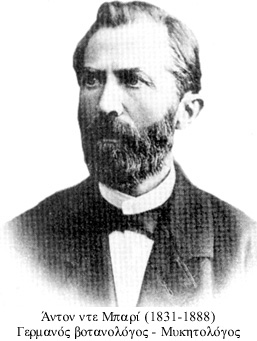 Άντον,
ντε Μπαρί (1831-1888)
Άντον,
ντε Μπαρί (1831-1888)
Γερμανός
Βοτανολόγος (Μυκητολόγος)
Πηγή: David Burnie: "Το Λεξικό της Φύσης", Εκδ. Ερευνητές, Αθήνα,1994
Bary, Heinrich Anton de
|
b.
Jan. 26, 1831, Frankfurt am Main [Germany] |
German botanist whose researches into the roles of fungi and other agents in causing plant diseases earned him distinction as a founder of modern mycology and plant pathology.
A professor of botany at the universities of Freiburg im Breisgau (1855-66), Halle (1867-72), and Strassburg (1872-88), de Bary determined the life cycles of many fungi, for which he developed a classification that has been retained in large part by modern mycologists. Among the first to study host-parasite interactions, he demonstrated ways in which fungi penetrate host tissues.
In his book Untersuchungen über die Brandpilze (1853; "Researches Concerning Fungal Blights"), he correctly asserted that fungi associated with rust and smut diseases of plants are the cause, rather than the effect, of these diseases. In 1865 he proved that the life cycle of wheat rust involves two hosts, wheat and barberry. He was the first to show (1866) that lichens consist of a fungus and an alga in intimate association; he coined the term symbiosis in 1879 to mean an internal, mutually beneficial partnership between two organisms.
De Bary also did important research on slime molds and sexual modes of reproduction in algae, and he wrote a comparative anatomy of phanerogams and ferns.
Copyright © 1994-2001 Encyclopædia Britannica, Inc.
Websites: